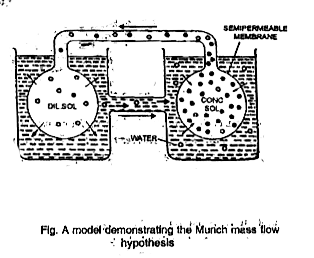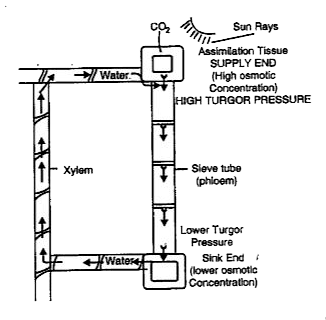Explain pressure flow of hypothesis of translocation of sugars in plants.
Or
Discuss Munch Hypothesis or pressure flow hypothesis:
Text Solution
Munch Hypothesis : Munch in 1927-30 gave a hypothesis to explain the mechanism of translocation organic solutes.
Definition. According to Munch hypothesis, there is translocation of solutes down the concentration gradient in mass i.e. from high osmotic pressure to low osmotic pressure due to the development of gradient of orgor pressure.
The munch hypothesis can be stimulated by an experiment. TWO osomometers ‘A’ and ‘B’ are connected each other by a delivery tube. ‘A’ osometer is filled with 20 per cent sugår solution and .B. osometer is filled th 5 per cent sugar solution. Both the osmometers are dipped in a trough having water.
In the beginning water diffuses into both.osmometers. But there is more diffusion of water into .A. mometer due to more concentrated sugar solution. They the solution in mass goes from ‘A. osmometer to .B. osmometer via delivery tube. The water from ‘B. osmometer comes into through and from tough water diffuses A osmometer. Again solution in mass goes from osmometer ‘A. to .B’, It continues till concentration in both osmometers becomes equal.
If anyhow osmometer ‘A’ is provided higher concentration than ‘B’ osmometer then flow of solution from to .B. via delivery tube and flow of water from .B. to .A. via trough would continue ceaselessly.
Munch applied the results of experiment to plants. In plants, food is always manufactured in mesophyll cells of leaves. This food passes into tubes along with water. Thus, the sieve tube mesophyll cells have higher concentration of minutes or in other words they have high osmotic Pressure. The food in sieve tubes get translocated of roots. In roots the food is either consumed or converted into insoluble state. Thus, the roots have X osmotic pressure. Roots are consumption ends “Sink" while leaves are supply ends or "Source". Therefore, the organic solutes get translocated lessly from supplý end to consumption end alongg with water via sieve tubes. In roots water is deducted in xylem vessels.

Evidences: (i) Sieve tubes have sugars or solutes under pressure, because an injury causes flow out of solution with abundance of organic solutes.
(ii) Organic solutes are translocated down the concentration gradient and there is 20% fall of concentration after every 8 metres. (Zimmermann)
(iii) The organic solutes and viruses translocated along with water with a speed of 60cm/h (Bennet).
(iv) The hypothesis is experimentally confirmed.
Objections: (i) Cytoplasm near the sieve plates exerts resistance to mass flow.
(ii) Water deficit does not impact on mass flow.
(iii) In case of germinating tubers cells near source end are flaccid
(iv) Catalado found that rate of flow of water is 72cm/h and solutes of 35cm/h while their flow must be same.

|
Similar Questions
Knowledge Check
The pressure flow of mass flow hypothesis of pholem translocation explains that
ASugars are loaded actively in sieve tubesBIncoming sugars are actively transported out of the phloem and removed as complex carbohydratesCLoss of solute produce as low ΨW in the pholemDMore than one option is correctMunch's mass flow hypothesis explains
Awater flow in xylemBhorizontal flow of water from cortex to xylemCtranslocation of solutes through phloemDabsorption of water by roots .
Explain the mass flow hypothesis of transport in phloem.
View SolutionExplain the meass flow hypothesis of transport in phloem
View SolutionWhat is the bulk or mass flow hypothesis ?
View SolutionWhat is the bulk or mass flow hypothesis ?
View Solution(a) Describe the pressure flow hypothesis of translocation of sugar in plants.
(b) Explain the mechanism of closing and opening of stomata.
View SolutionExplain the River Popper hypothesis.
View Solution
